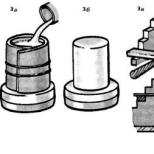Is it possible to paint polymer clay. How to paint polymer clay: acrylic coatings and others than paint, instructions, videos and photos. Clay dye ink
How to paint polymer clay Follow the link right now ️ http://vk.cc/534CSe and buy polymer clay and everything you need to work with it. ️ If you do not find the desired product, leave an order in the discussions of the "Ordering goods" group, and we will deliver it to you within 3-5 days! Polymer clay is a plastic material based on PVC particles, it is intended for modeling small sculptures, jewelry and other products. When working with the material, it is required to wear rubber gloves, as well as follow basic safety rules. Polymer clay is conventionally divided into two large categories: one hardens by air drying, the second requires baking at a high temperature (for example, in an oven). Both types of clay can be painted, but there are some nuances. Baked polymer clay Various manufacturers offer baked polymer clay in a huge spectrum of colors. You can additionally paint it, if necessary. Suitable for this: - acrylic paints; - gouache; - pastel; - wax crayons and pencils; - chalk. After the clay product has been baked in the oven, it must be cooled. It is not recommended to paint over hot polymer clay as it can cause burns. And the paint won't stick at all. The only exception is pastel. It is used to paint a product that has not yet been baked in the oven. For painting, it is recommended to use soft brushes made of natural hair, so as not to violate the integrity of the composition. Self-hardening polymer clay This type of clay is presented in a very meager palette: white, gray and terracotta shades. Some manufacturers have expanded the color spectrum of polymer clay, which naturally cures in air. For example, "Fimo" offers not only standard colors, but also bright shades that can be mixed into the base color, making it original and unique. There are two options to color self-curing polymer clay. The first is to add paint to the base plastic during kneading. Only water-based acrylic paints are suitable for this purpose. Add a little paint to the mass, knead the clay. If there is not enough brightness, you can add a little more paint. Several colors can be mixed for an unusual shade. If the clay is mixed unevenly, a very original and unique color of the product can be obtained. The second is to paint an object already molded from clay. Not only acrylic paints are suitable for this, but also oil, pastel and gouache paints. You need to apply paint on an already hardened finished object. Once the paint is dry, it can be cured with clear varnish. This will give additional strength to the polymer clay product. It has been noted that some paints change color after drying. To prevent this from happening, you need to apply them in several dense layers, each of which must be dried. Follow the link right now ️
Polymer plastic is used for small sculptures, products and ornaments. With the help of self-made sculptures, you can give any interior originality and exclusivity.

Ceramic products help to complement and dilute the interior with graceful figures or decorations in any color scheme that emphasize the individuality of the room or room. And in order to create unique polymer clay products that would perfectly suit your style or fit into the interior, you need to know how to use paint to add an attractive look, because the plastic itself is white.
Clay for home-made interior decorations is conventionally divided into two categories:
- the first option hardens by air drying;
- the second option is a material that needs to be exposed to high temperatures, it is baked.
However, any type of work requires accuracy and care in the manufacture of the product.
Rules for working with plastic
In order for the creation process to deliver only pleasant sensations, follow these rules:
- It is advisable to work with clay with gloves.
- Upon completion of use, plastics, hands, tables and other items that have been used must be thoroughly washed.
- It is not recommended to take plastic or polymer boards.
- All additional tools for working with plastics cannot be used for other purposes (boards, knives and other tools should not be used for cooking).
- When working, take into account all the rules and advice of the manufacturer regarding storage, hardening or baking of clay.
Using paints to work with clay
Despite the fact that there is polymer clay in the desired color, and you can do without additional coloring compounds, but it is the paint that makes the product brighter, improves the quality and appearance of the product. Several types of dyes can be used for staining:
- acrylic;
- oil;
- ink;
- spray can;
- crayons and pencils;
- powder.
The amount of paint used depends on the desired color. In order to give the product a delicate and pastel color, it is necessary to use a minimum amount of material, and in order for the color to be bright and saturated, the amount of substance can be safely increased.
After adding a coloring material, the clay must be thoroughly kneaded, otherwise the product will turn out with uneven, colorful stripes, such variations are also used in jewelry and products.
When using several color options, the paint must be selected from the same type and manufacturer in order to avoid combining different densities, colors and differing characteristics. Manufacturers provide tables that help you achieve the desired color by combining and mixing the available paints.

Characteristics of coloring compositions
Colorful products are distinguished by lightfastness, which will help to understand the marking of paints. The lightfastness of paints is indicated by asterisks. The most suitable dyes are two or three stars.
For the base of the product, markings with a black square or a half-filled square are suitable - such colorful materials can get rid of the transparency of polymer clay. The white square denotes transparency, which will give the product the properties of cold porcelain. A strikethrough white icon indicates that the colorant is translucent.
Preparatory stage
Before working with polymer clay, you need to prepare all the tools that you need to paint the material:
- palette for paints;
- brushes;
- container with water;
- napkins or paper;
- sponge.
Before applying coloring materials, a primer must be applied to the clay. Priming the surface will allow you to achieve a more uniform and high-quality color when applying paints.

Acrylic paints
Painting with acrylics is most widely used. It is necessary to use high-quality artistic acrylic paints as a material for painting. It is better to take them for working with clay that does not require baking. However, if such material is available, several staining experiments can be carried out.
It is important to take into account the peculiarity of acrylic paint - darkening after drying. At the first experience with plastics and paints, it is necessary to practice the use of dyes on paper, paying attention to the color and the time spent on drying.
The main disadvantage of acrylic painting is fast drying. However, there are options and work opportunities to help avoid this:
- The first option is a drying retarder. An additional tool for work can be purchased along with the paints.
- Using a small amount of pigment on the palette to save drying material.
- To prepare more color, it is recommended to use jars that can be closed for the next use.
Oil paints for polymer clay
Oil paints are great for working with any kind of polymer material. When choosing a paint, you need to pay attention to the reviews about this product, the paint base (oil) and the test results. For the experiment, you can apply a small amount of paint to the baked clay and leave the material to dry. A positive result will be the lack of stickiness of the paint one month after application.

Oil coloring options allow you to create amazing details and decoration elements:
- A small amount of material is used to make products for bedding and delicate colors;
- Using a sponge or fabric, you can create the appearance of an antique surface. To do this, you need to paint on the product and remove most of the material with a cloth;
- The paint will help to create an imitation of precious stones in the product;
- To obtain a "marble" product, a colorful substance is mixed with clay before the decoration is baked.
The main disadvantage of using oil coloring agents is the drying time. The full period can take up to six months, depending on the size of the product and the amount of material used.
Clay dye ink
For coloring polymer clay, you can use special colored ink. A wide range of inks allows you to paint a product in a translucent or transparent color, draw drawings on parts, tint them, and give a marble look.
When using ink for coloring, it is necessary to study their properties, rules of use, drying time and interaction with clay. Reviews or independent experiments will help you with this.
Powder, crayons and pencils
You can create a metallic effect, additional colored elements that highlight the product, using powder or crayons for coloring polymer clay.
The pearlescent powder gives the details a shine and shine effect. Powder colorant can be mixed with acrylic or oil paint base. A big plus in using powder is its amount, and you need to use very little material to work.
Crayons with pencils are also used in small quantities. However, they require additional work. To use them, you first need to grind the coloring materials to a powder state. Pencils are used to create additional drawings and decoration elements.
Clay coloring aerosols
Sprays as colorants allow you to paint the clay in a variety of colors with smooth and accurate transitions. Before using the spray, the clay is polished and covered with an acrylic base.
The main disadvantage of this coloring option is the price of aerosols. Therefore, this method of painting the product is used only by professional firms and specialists.
Working with polymer clay requires a lot of preparation and time. To do this, you can study video tutorials, understand the basic rules and features of clay products.
The efforts and time spent will reward the "sculptor" with exclusive decorations, original accessories and unique interior details.
Some craftsmen prefer white self-hardening clay. This is very convenient, first of all, because it does not need to be baked. How is it easier to paint small items made of such clay? In this master class, we will look at how to paint polymer clay at home with acrylic paint.
We need: 2 jars of yogurt, a nail.

The yoghurt containers must be sized and one must be fully inserted into the other to the very bottom. It is very important. So it will be better to paint and paint will be needed much less.

We take a smaller container and make holes with a nail along the entire surface of the bottom.

Here's a mini sieve we get.

Now everything is ready for painting. We insert our sieve into a large one. We take our small ones. We dilute 1x1 acrylic paint with water, make the color we need.

We put a small amount of parts in our homemade sieve.

We fill our bowls with paint, it is desirable that the entire surface of the products is covered with paint. Shake our paint cans for a couple of seconds. The main thing is not to overexpose the clay in the liquid, otherwise it may start to melt.

We take out our sieve from the main jar. The paint should all drain into a large one.

Now we turn over our sieve and pour our products onto polyethylene or foil. This must be done to allow our crafts to dry.

After drying with a thin brush, paint over the places of the folds.

So it is very convenient and quick to paint.

Now you can make all kinds of beauty.


So, the answer to the riddle in the last post. There are those who like to paint polymer clay BEFORE baking.
The phrase "alcohol-based ink or alcohol ink" is often used in such posts. Until some time, such Pinata color ink was supplied to Russia. But ... now the supplies have stopped and, therefore, there is nothing to paint the plastic with. Water-based paints bubble, flake on the gel and spread over hard plastic. In this connection, I conducted a series of experiments with household dyes.
I liked the experiment, I will continue it further. And I will share with you the results gained during the week.
All dyes were mixed with liquid gel. This is Fimo.
This is a banal "touch". Correcting liquid on alcohol ...
The comma is drawn with nail art paint.
This is Copic refill alcohol ink. In the first cases, it is undersized. If you get the same result on a sample. Just stir better.
The same additive. Only red and better mixed. WARNING. Yesterday in the cafe Liva and Larisa said that this ink does not fit. Because they go in bubbles, like water ones. When I came home, I saw that the sample from the master class was exactly the same garbage. If you press it with a fingernail or a pencil, then a trace remains on the surface. My version is this - either this is a property of liquid plastic after baking, or a thick layer of the mixture. Today I deliberately tried to cover the plastic with a thinner layer and managed to avoid this drawback.
It's Fimo again Water-based Pebeo stained glass paint designed for high temperatures. Bubbles even without gel. And with the fimo gel it turned out to be just a porous surface.
Further, no pictures. I tried ordinary domestic alcohol ink for a printer (unlike Japanese ones, they cost 300 rubles, not 20, but 200 grams). They lay down well in a thin layer and withstand baking, with a thick layer they form bubbles that can be pierced. WARNING. You need to take them either with a needle or with a thin knitting needle. Printer ink gets very dirty. Work better with gloves. I knitted a ceramic palette, which I immediately washed with a damp cloth to its original cleanliness.
The ink can be mixed with Japanese ink.
I also tried nail polish. It turned out beautifully. In terms of beauty, surface evenness, gloss, opacity, it is most similar to enamel. WARNING. It will take time to understand whether this varnish is suitable for this plastic.
Conclusions.
Even with no proven alcohol-based ink available, there are dyes that can be used on raw polymer clay for baking.
If you like some of the results, you can start the experiment.
If not, let my experience tell you what is not worth wasting time and money on.
The effect of staining raw plastic depends not only on the base of the dye - alcohol or water. All other components are equally important - plasticizers, biocides, surface tension regulators. EVERYTHING must be tried.
No less important are the thickness of the dye layer, the mixing quality, the ratio of different dyes in one mixture.
Actually, I like to paint the already baked plastic more.





